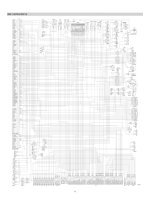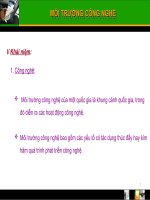Chapter 2 grain texture
Bạn đang xem bản rút gọn của tài liệu. Xem và tải ngay bản đầy đủ của tài liệu tại đây (3.95 MB, 231 trang )
Chapter 2. Grain Texture
Clastic sediment and sedimentary rocks are made up of discrete particles.
The texture of a sediment refers to the group of properties that describe
the individual and bulk characteristics of the particles making up a
sediment:
Grain Size
Individual
Bulk (Grain Size Distribution)
Grain Shape
Grain Orientation
Porosity
Permeability
}
Secondary properties
that are related to the
others.
These properties collectively make up the texture of a sediment or
sedimentary rock.
Each can be used to infer something of:
The history of a sediment.
The processes that acted during transport and deposition of a
sediment.
The behavior of a sediment.
This section focuses on each of these properties, including:
Methods of determining the properties.
The terminology used to describe the properties.
The significance of the properties.
Grain Size
I. Grain Volume (V)
a) Based on the weight of the particle:
m = Vρ S
Where:m is the mass of the particle.
V is the volume of the particle.
ρs is the density of the material making up the particle.
(ρ is the lower case Greek letter rho).
1. Weigh the particle to determine m.
2. Determine or assume a density.
(density of quartz = 2650kg/m3)
3. Solve for V.
m
V =
ρS
Error due to error in assumed density;
Porous material will have a smaller density and less solid volume so
this method will underestimate the overall volume.
b) Direct measurement by displacement.
b) Direct measurement by displacement.
b) Direct measurement by displacement.
Accuracy depends on how accurately the displaced volume can be
measured.
Not practical for very small grains.
For porous materials this method will underestimate the external volume
of the particle.
c) Based on dimensions of the particle.
Where:d is the diameter of the particle
And the particle is a perfect sphere.
Measure the diameter of the particle
and solve for V.
Problem: natural particles are rarely spheres.
πd
V =
6
3
II. Linear dimensions.
a) Direct Measurement
Natural particles normally have irregular shapes so that it is difficult
to determine what linear dimensions should be measured.
Most particles are not spheres so we normally assume that they can be
described as triaxial ellipsoids that are described in terms of three
principle axes:
dL or a-axis
longest dimension.
dI or b-axis
intermediate dimension.
dS or c-axis
shortest dimension.
To define the three dimensions requires a systematic method so that
results by different workers will be consistent.
Sedimentologists normally use the Maximum Tangent Rectangle Method.
Step 1. Determine the plane of maximum projection for the particle.
-an imaginary plane passing through the particle which is in contact with
the largest surface area of the particle.
The maximum projection area is
the area of intersection of the plane
with the particle.
Step 2. Determine the maximum tangent rectangle for the maximum
projection area.
-a rectangle with sides having maximum tangential contact with the
perimeter of the maximum projection area (the outline of the particle)
maximum
tangent
rectangle
Step 2. Determine the maximum tangent rectangle for the maximum
projection area.
-a rectangle with sides having maximum tangential contact with the
perimeter of the maximum projection area (the outline of the particle)
dL is the length of the rectangle.
dI is the width of the rectangle.
Step 3. Rotate the particle so that you view the surface that is at right
angles to the plane of maximum projection.
dS is the longest distance through the particle in the direction normal to
the plane of maximum projection.
The volume of a triaxial ellipsoid is given by:
V=
π
6
dL x dI x dS
For fine particles only dL and dI can be measured in thin sections.
Thin sections are 30 micron (30/1000 mm) thick slices of rock through
which light can be transmitted.
Click here to see how a thin section is made.
/>
Axes lengths measured in thin section are “apparent dimensions” of the
particle.
The length measured in thin
section depends on where in the
particle that the plane of the thin
section passes.
Axes lengths measured in thin section are “apparent dimensions” of the
particle.
The length measured in thin
section depends on where in the
particle that the plane of the thin
section passes.
Axes lengths measured in thin section are “apparent dimensions” of the
particle.
The length measured in thin
section depends on where in the
particle that the plane of the thin
section passes.
For a spherical particle its true
diameter is only seen in thin section
when the plane of the thin section
passes through the centre of the
particle.
The three axes lengths that are commonly measured are often
expressed as a single dimension known as the nominal diameter of a
particle (dn):
dn is the diameter of the sphere with volume (V1) equal the volume (V2)
of the particle with axes lengths dL, dI and dS.
V1 = volume of the sphere.
V2 = volume of a particle.
(a triaxial ellipsoid)
π 3
V1 = d n
6
π
V2 = d L d I d S
6
By the definition of nominal diameter, V1 = V2
Therefore:
π 3 π
dn = d L d I ds
6
6
π 3 π
dn = d L d I ds
6
6
dn can be solved by rearranging the terms:
6 π
d = × dLdI ds
π 6
3
n
π 3 π
dn = d L d I ds
6
6
dn can be solved by rearranging the terms:
6 π
d = × dLdI ds
π 6
3
n
π 3 π
dn = d L d I ds
6
6
dn can be solved by rearranging the terms:
6 π
d = × dLdI ds
π 6
3
n
π 3 π
dn = d L d I ds
6
6
dn can be solved by rearranging the terms:
6 π
d = × dLdI ds
π 6
3
n
d = dLdI ds
3
n
Therefore:
dn = 3 d L d I ds
Nominal diameter
b) Sieving
Used to determine the grain size distribution
(a bulk property of a sediment).
A sample is passed through a
vertically stacked set of square-holed
screens (sieves).
A set of screens are stacked, largest holes on top, smallest on the bottom
and shaken in a sieve shaker (Rotap shakers are recommended).
Grains that are larger than the holes
remain on a screen and the smaller
grains pass through, collecting on
the screen with holes just smaller
than the grains.
The grains collected on each screen
are weighed to determine the weight
of sediment in a given range of size.
The later section on grain size distributions will explain the method more
clearly.
Details of the sieving method are given in Appendix I of the course notes.









